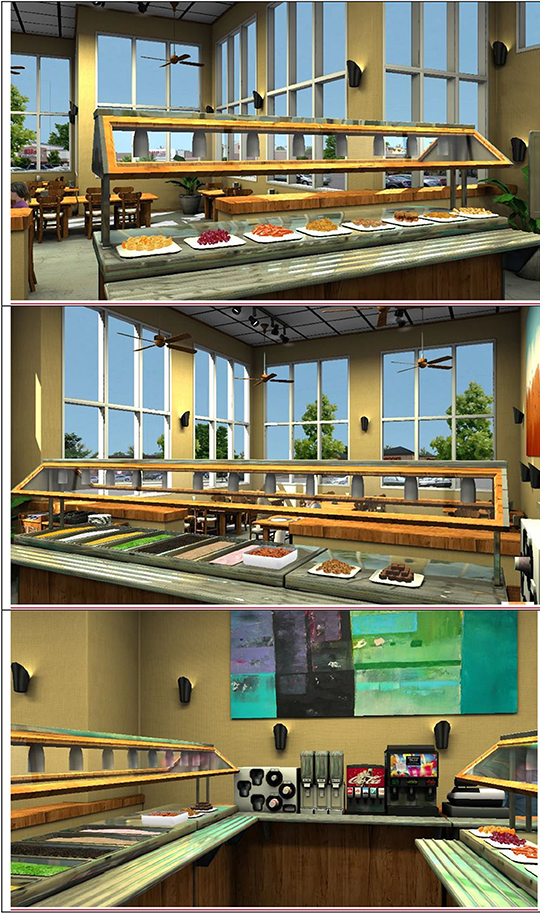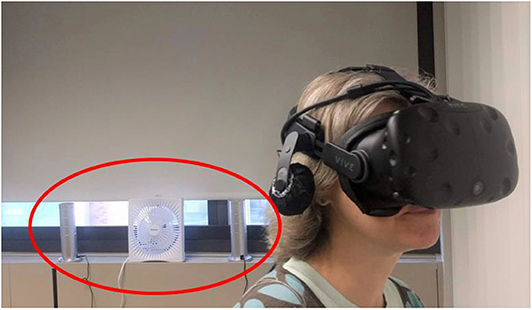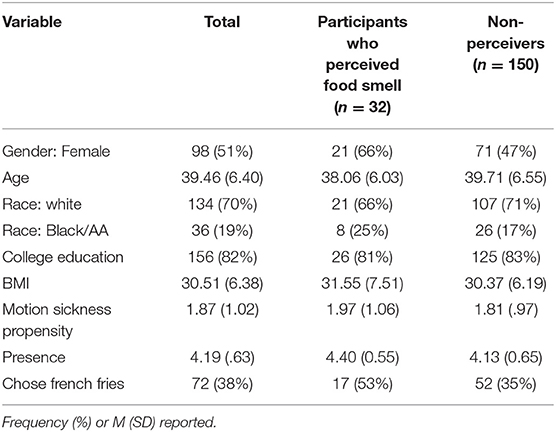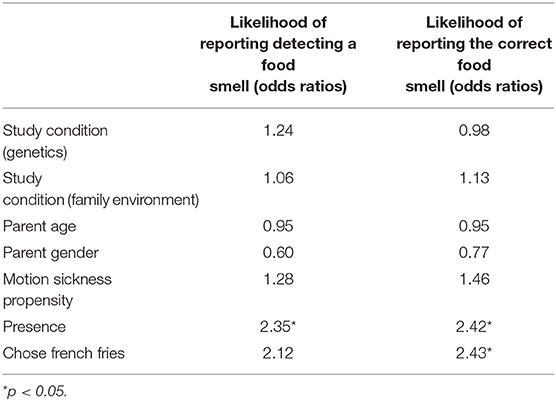- Social and Behavioral Research Branch, National Human Genome Research Institute, Bethesda, MD, United States
Virtual reality (VR)'s effectiveness as a medium for training, education, research, and entertainment, is based in large part on the fact that users can be deeply immersed and feel present within virtual environments. Olfaction has received less attention regarding its ability to add realism to VR environments. It is important to investigate under which circumstances olfactory stimuli are likely to add to user experience and help achieve the goals of VR applications. This study examined the role of scent in a VR-based buffet restaurant environment. French fry scented oil was administered while participants made a plate of food in the VR Buffet. Participants were asked afterwards to report on smells they perceived. Only 18% of participants perceived the olfactory stimulus, 78% of whom correctly identified it. Perceiving the olfactory stimulus was associated with higher levels of presence in the VR Buffet. Correctly identifying the olfactory stimulus was associated with heightened presence and increased likelihood of choosing french fries from the VR Buffet. These results demonstrate the potential for variability in scent perception and related user experience in VR. Additionally, this study highlights a need for future research into factors that underlie and moderate olfactory perception in VR environments.
Introduction
Virtual reality (VR) is quickly evolving as a valuable tool for training, education, research, entertainment, and other applications (Parsons et al., 2017; Kyaw et al., 2019; Persky and Lewis, 2019; Checa and Bustillo, 2020). The bedrock of VR's effectiveness is the fact that users can be immersed in virtual environments as if they were real, such that experiences and behaviors learned in VR transfer into real-world contexts (Blascovich et al., 2002). Presence, or the psychological experience of existing within the VR environment, is the conceptual mediator through which many VR applications are typically believed to achieve these successes (Slater and Wilbur, 1997). VR developers most often focus on the visual and auditory aspects of the simulated environment. Accordingly, this is where much of the research literature lies, evaluating the role of elements such as visual richness, stereoscopic vision, image quality, and sound quality in evoking presence (Schubert et al., 1999; Cummings and Bailenson, 2016). In some contexts, however, other senses are likely to be important for creating realistic and holistic VR settings. Olfaction has received less attention in regard to its ability to add realism to VR environments, although there are many potential benefits of including this sense in VR simulations (Spence et al., 2017). Certainly, olfaction is influential in real-world experiences (e.g., food, place memory) (Willander and Larsson, 2007; Zoon et al., 2016). Existing studies on the subject have shown olfaction to be influential in VR experience as well. Most notably, scent stimuli have been shown to increase participants' sense of presence in many, but not all, VR environments. For example, participants self-reported greater presence in VR environments designed for exposure therapy when administered relevant olfactory stimuli; in another case, the scent of basil enhanced presence for participants immersed in a 360 video showing street vendors in a public square (Munyan et al., 2016; Narciso et al., 2020). Evidence from a virtual environment exploring the four seasons suggested that the addition of an olfactory component increased user presence (Ranasinghe et al., 2018). In other work, an unpleasant odor paired with a VR-based kitchen scene increased presence while a pleasant scent did not (Baus and Bouchard, 2017); a follow-up study with slightly different visual VR stimuli found that both pleasant and unpleasant odors increased the sense of reality but that neither had any significant effect on presence (Baus et al., 2019). Dinh et al. (1999) did not find a significant effect of an olfactory stimulus on presence; however, they demonstrated that providing a localized coffee scent improved recall for the location of the scent's source. Similarly, Egan et al. (2017) found that wood, coffee, and gunpowder scents did not increase immersion when presented alongside relevant VR audiovisual stimuli. Scent exposure can also influence cognition and behavior during or after VR use. For example, de Groot et al. (2020) found that participants exposed to a cleaning-related smell exhibited more motivated cleaning behavior in VR; Li and Bailenson (2018) demonstrated that participants who experienced a virtual donut alongside olfactory cues exhibited a satiation effect.
Olfaction is not routinely integrated into VR environments; however, dedicated hardware tools are emerging to make this possible. It is important to conduct research to understand under which specific circumstances olfactory stimuli are likely to add to user experience and help achieve the goals of a VR application. For this analysis, we consider data from a larger research trial related to parents' food choices for their child in a VR-based buffet restaurant environment (Persky et al., 2018). This is a setting where olfactory cues are typically present in the real world and where these smells might be expected to influence individual behavior (Ramaekers et al., 2014). Prior to beginning this study, administration of the olfactory stimulus was extensively pilot tested. The research team perceived that experiential levels of the stimulus were very high, and pilot participants who were not situated in VR noticed the scent. However, as we began collecting data from participants using VR, we anecdotally observed that scent was infrequently remarked upon. As such, we conducted the current analysis to assess olfactory perception in the larger research trial. The overriding goal was to evaluate whether and for whom the use of scent was impactful within this context: the use of a single ambient scent within a food-oriented VR environment wherein participants were not specifically alerted to the presence of an olfactory stimulus. Findings on this front have been mixed in previous research (Baus and Bouchard, 2017). We anticipate that this question would be of interest to researchers and others who wish to immerse users in a food-oriented VR simulation without making scent a centerpiece or a focus of inquiry.
Research questions for this analysis are therefore as follows. First, were participants who reported perceiving the olfactory stimulus able to correctly identify it? This would indicate conscious awareness of the stimulus. Second, what participant and contextual factors were associated with perception of the olfactory stimulus? Along with presence in the VR environment, which has been demonstrated in previous studies, we also explore participant variables (gender, age, motion sickness propensity), as well as behavior within the VR environment (choice of associated food).
Methods
Participants
Participants included 190 parents with a 3–7 year-old biological child with no major food allergies to VR Buffet items, diet-related health conditions, developmental delays, or dietary restrictions that would limit ability to eat most foods on the VR buffet. Participants were recruited from the metropolitan Washington, D.C., area and were compensated $90 for completing all parts of the study. Inclusion criteria included self-reported overweight, some responsibility for child feeding, and the ability to read and write in English. Exclusion criteria included having a vestibular or seizure disorder, high propensity for motion sickness, known pregnancy, uncorrected poor vision or hearing, past or current eating disorder, or previous participation of another household member or another biological parent of the relevant child in the study. Recruitment was stratified to ensure an equal representation of mothers and fathers. Recruitment methods included posting advertisements in social and traditional media, posting flyers, and word-of-mouth. This study was approved by the IRB of the National Human Genome Research Institute.
Measures
Data were collected as part of a larger experimental trial (Persky et al., in press). The experimental conditions included provision of genetic information (presence vs. absence) and provision of family environment information (presence vs. absence). The experimental conditions were not expected to influence the outcomes of the present study and thus were only assessed as covariates in regression models.
We used a single item to assess whether participants smelled the olfactory stimulus. The wording for this item was: “I smelled food in the virtual buffet” with a 1–5 response scale where 1 = strongly disagree and 5 = strongly agree. Due to the bimodal nature of responses on this item, we binned responses into 0 = did not smell the stimulus (consisting of response options 1–3 on the original scale), and 1 = did smell the stimulus (consisting of response options 4–5 on the original scale).
We then asked participants to identify the smell with the following free-response item: “What did you smell?” Although the stimulus oil was sold with the label “french fries” (see Materials section), researchers noted that fried foods, fast food, or chicken would also be a good match for the character of the odor. These responses were all counted as correctly identifying the smell.
Potential correlates assessed in analyses included demographics (participant age, gender) which were collected at screening and pre-test. We assessed participants' propensity for motion sickness and included this as a proxy for possible discomfort in the environment. This was assessed at screening with the following item: “How easily would you say that you get motion or car sickness on a scale of 1 to 7 where 1 would be that you never get motion sick?” Those participants who rated themselves a 6 or 7 were ineligible for the study. As such, the range of scores for participants in this study is from 1 to 5. We assessed self-reported presence using a 5-item scale (Fox et al., 2009). A sample item is: “To what extent were you involved in the virtual world?,” with response options ranging from 1 = not at all to 5 = extremely (see Supplement 1). Item responses were averaged. Finally, we included a binary variable indicating whether or not participants chose any servings of french fries from the virtual buffet (i.e., the food that most closely matched the smell stimulus) according to data collected automatically by the VR system.
Materials
The VR Buffet is a VR environment designed to assess parental food choice behavior for their child (Figure 1). It is described in detail elsewhere (Persky et al., 2018). In this study, participants used a standard HTC Vive headset with two controllers to experience content. We used the standard auditory stimuli that accompany the environment (sounds paired with actions in the buffet and a field recording of restaurant noises). The olfactory stimulus was administered using two nebulizing scent diffusers (Aeromini Delux by AromaTech Inc.) on one end of the room (Figures 2, 3). Between the diffusers was a fan which distributed the smell in the direction of users so that the olfactory stimulus could be smelled as users moved around the room. After extensive pilot testing, we chose to administer the scented oil continuously on the highest setting for ~45 s at the beginning of the VR environment usage during the voiceover instruction period to give it time to disperse. The fragrance oil used was “french fries” from saveonscents.com, at standard concentration. We chose this scent because, in our anecdotal experience, fried food smells tend to permeate food environments, and because there were french fries available on the virtual buffet. Research assistants reported the smell to be very strong when administered to participants. Between each participant, scent was removed from the room using a Honeywell HEPA air purifier (model HPA300). No two participants completed the study within less than an hour of each other, giving time for lingering odor to be dispersed between participants.
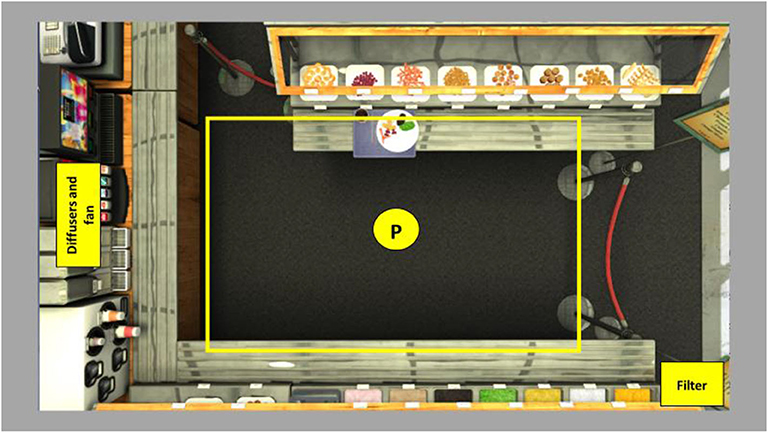
Figure 2. Overhead view of VR Buffet environment with approximate location of olfactory equipment. Circle labeled “P” is starting point of participant; open yellow box represents tracking area within the physical room.
Procedure
Participants were screened online or by telephone. For eligible participants, an index child was identified who met study criteria (see Participants). Participants consented to participate online and continued to the online pre-test questionnaire, which included baseline measures of attitudes, beliefs, and demographic characteristics. Participants were contacted by phone to schedule an appointment for a lab visit. At the visit, participants were consented again and trained on use of the VR Buffet (with no use of scent during the training period).
Participants then received information about their child's future risk for obesity based on randomized condition (control, genetic information, family environment information, gene-environment interaction information); this was the primary focus of the larger parent study. Following information provision, participants filled out a short questionnaire then used the VR Buffet to choose a virtual tray of food and drink for their child. During use of the VR Buffet, scent was administered to the participants as detailed in the Materials section. Following the VR Buffet session, participants filled out a final questionnaire in the lab, during which they were asked about their perception of olfactory elements of the VR Buffet.
Results
Descriptive Statistics
Demographics and variable means are available in Table 1. Participant reports of whether they smelled food in the VR Buffet are available in Figure 4. Overall, only 17.6% of participants reported smelling food. Among those who reported smelling food, 25 of 32 correctly identified the food type associated with the smell (see Table 2).
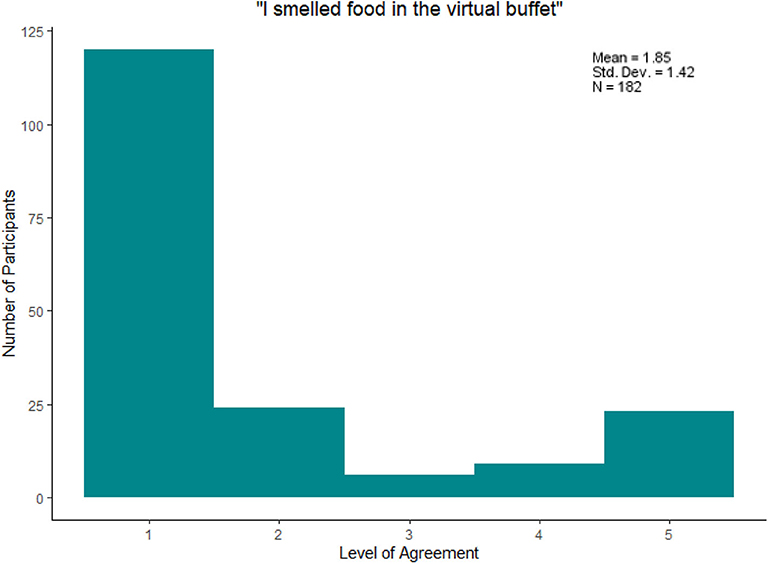
Figure 4. Frequencies of reporting each response on the scale from 1 = strongly disagree to 5 = strongly agree in response to the item “I smelled food in the virtual buffet”.
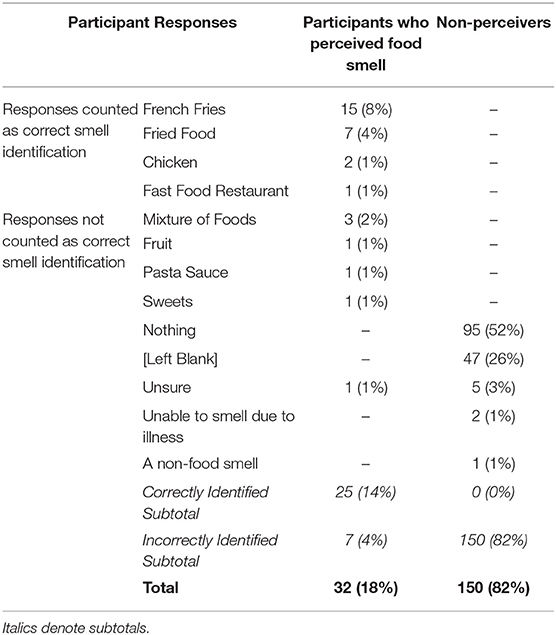
Table 2. Open-ended smell identification responses by whether or not participants perceived food smell.
Predictors of Smelling Food
We assessed several potential correlates of noticing the olfactory stimulus using binary logistic regression (see Table 3). We first regressed several predictor variables (parent gender, parent age, motion sickness propensity, presence rating, and whether or not participants selected french fries in the VR Buffet) and control variables (assignment in each of two experimental conditions for the larger study) on the likelihood that the participant reported smelling any food. The logistic regression model was significant [ = 14.44, p < 0.05], with 12.6% of the variance explained and 81% of responses correctly classified. In this model, presence in the VR environment was the only significant predictor [OR = 2.35, Wald = 4.98, p = 0.026]. For each 1-point increase on the presence scale, participants were 135% more likely to report smelling the stimulus (Figure 5). We ran a second binary logistic regression regressing the same predictors on the likelihood the participant reported smelling food and correctly identified the olfactory stimulus on the open-ended item. The logistic regression model was significant [ = 14.09, p < 0.05], with 12.8% of the variance explained and 84% of responses correctly classified. Participants who reported smelling food but did not correctly identify the food were excluded from this analysis. We found similar results for presence [OR = 2.42, Wald = 4.93, p = 0.026] and additionally found that those participants who chose french fries in the VR Buffet were 143% more likely to report smelling the stimulus than those who did not [OR = 2.43, Wald = 4.33, p = 0.037].
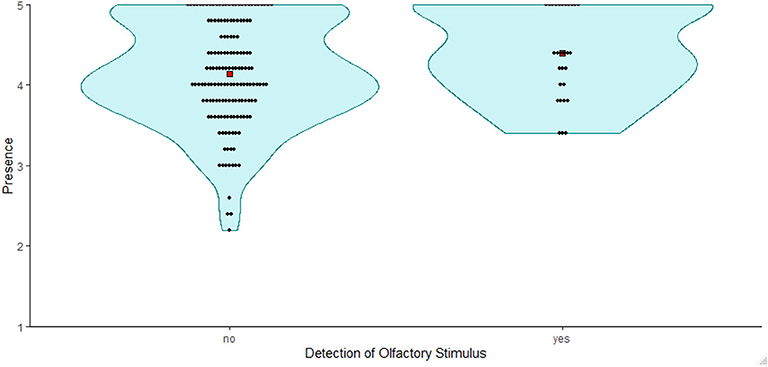
Figure 5. Violin plot of presence in the VR buffet for participants who did or did not perceive the olfactory stimulus.
Sensitivity Analysis
To further examine the role of potential lingering odor in the experiment room which could lead participants to dissociate scent from the VR buffet we also assessed data from only the first participant to be run in the laboratory on a given day (n = 138). Among only first-of-day participants, the odor detection rate was similar (13%). Logistic regressions conducted among only these participants reveal similar patterns of odds ratios, though previously significant predictors do not always reach statistical significance given the smaller sample size (see Supplement 2).
Discussion
This analysis describes an underexplored phenomenon in which fewer than one-fifth of participants in a VR-based study reported noticing a strong olfactory stimulus intended to function as an ambient part of the virtual environment experience. Reports were fairly bimodal, suggesting that participants either did or did not notice the scent, with no middle ground in reporting. As presence in VR can direct attention away from stimuli judged as VR-irrelevant (Kober and Neuper, 2012), many participants may not have made the connection between the VR environment and the scent stimulus. However, several participants clearly did direct conscious attention to the stimulus. Indeed, the vast majority of those who reported noticing the stimulus correctly identified it, suggesting that this perception was real and within conscious awareness. Identifying reasons for the low rate of olfactory perception will require more research. One intriguing possibility stems from a finding in real-world environments, wherein olfactory signals are less likely to be noticed when the visual sensory system is highly stimulated (Forster and Spence, 2018). It may be that the very visually stimulating environment of the VR Buffet caused a lack of attention to the olfactory system among participants. Similarly, the interactive nature of the VR Buffet may have also detracted from users' attention to smell. We plan to address these possibilities in future research.
We identified two factors that were associated with perception and correct identification of the olfactory stimulus: presence in the VR environment and whether or not participants selected french fries (i.e., the food associated with the stimulus) in the VR Buffet. It is important to note that, in both cases, the directionality of this association is unknown. Participants may have selected fries in the VR Buffet due to the smell or may have perceived the smell in conjunction with selecting fries. Similarly, it may be that participants felt more presence due to the smell, or that those who felt more present perceived the smell. Previous work has demonstrated that including scent in VR scenes can increase users' sense of presence; notably, the current work did not manipulate the availability of a scent but rather explored scent detection. Interestingly, past research has suggested that scent can influence food selection behavior (Ferriday and Brunstrom, 2008; Proserpio et al., 2016), and scent can also elicit increased visual attention to congruent foods (Seo et al., 2010). However, conscious awareness of an olfactory stimulus is not necessary for that stimulus to drive associated food choice behavior (Gaillet-Torrent et al., 2014).
This analysis has limitations, particularly as it was not designed to specifically assess olfaction. We did not assess the fit of the HTC Vive headset on each individual participant to ensure that it did not interfere with breathing through the nose; however, our assessment after the study suggests that this is rarely the case. In addition, the smell administered was static and participants were likely to habituate to it over time. We also did not assess general ability to smell among participants in the study. This may influence the rate at which participants report detection of the scent, however, it is unlikely to have influenced the relationships between scent detection and other variables (e.g., presence). Additionally, insufficient ability to smell is uncommon; Munyan et al. (2016) only excluded 4% of recruited individuals from their study of olfactory stimuli in virtual environments due to subthreshold olfactory ability (Zoon et al., 2016). Finally, the participants in this study were parents of 3–7 year-old children and thus age of participants was naturally constrained.
It is also important to note that we did not tell participants that olfaction was an element of the VR environment. Due to the method we used to administer smell (room-based), scent administration equipment was not obvious to participants. In the future there is likely to be variability as to how explicitly scent stimuli are pointed out to VR users. For example, scent is frequently used in retail settings to enhance customer experience without notification (Bradford and Desrochers, 2009). Results are likely to differ when participants are made aware of olfactory stimuli either verbally or through the use of obvious hardware peripherals. However, this set-up made it possible for us to investigate unprompted participant awareness of olfactory cues. Future research on the influence of olfactory cues depending upon whether or not they are disclosed to participants may be of interest. Indeed, a previous study in which scent stimuli were not disclosed to participant also found low rates of scent detection for a pleasant (but not unpleasant) scent in VR (Baus and Bouchard, 2017). Importantly, in this other study, scents were detected when participants were exposed to them outside of VR.
Taken together, these findings suggest a need for more research to identify cases and contexts under which olfactory stimuli will add to VR environments to increase presence and benefit user experience. While they may be very influential in some VR contexts, there may be cases under which these stimuli go unnoticed. In addition to addressing such applied research questions for optimizing VR applications, we also note that from a basic research perspective, research in virtual contexts affords an opportunity to learn about human olfaction and perception within controlled yet ecologically valid study settings.
Data Availability Statement
The raw data supporting the conclusions of this article will be made available by the authors, without undue reservation.
Ethics Statement
The studies involving human participants were reviewed and approved by IRB of the National Human Genome Research Institute. The patients/participants provided their written informed consent to participate in this study.
Author Contributions
SP designed the study, conceived of the manuscript, conducted data analysis, wrote drafts, and edited the manuscript. AD conducted pilot testing, wrote drafts, and edited the manuscript. All authors contributed to the article and approved the submitted version.
Funding
This study was supported by the Intramural Research Program of the National Human Genome Research Institute (z01-HG200384-08).
Conflict of Interest
The authors declare that the research was conducted in the absence of any commercial or financial relationships that could be construed as a potential conflict of interest.
Acknowledgments
We thank Chris Fortney for his assistance with pilot testing the olfactory stimuli. We thank William Kistler, Haley Yaremych, and Sarah Boland for assistance with study planning and data collection, and Mac Gbenro, Rachel Solonsky, and Chris Fortney for assistance with data collection. Thank you to Emma Schopp and Sydney Telaak for assistance with manuscript preparation.
Supplementary Material
The Supplementary Material for this article can be found online at: https://www.frontiersin.org/articles/10.3389/frvir.2020.571812/full#supplementary-material
References
Baus, O., and Bouchard, S. (2017). Exposure to an unpleasant odour increases the sense of Presence in virtual reality. Virtual Real. 21, 59–74. doi: 10.1007/s10055-016-0299-3
Baus, O., Bouchard, S., and Nolet, K. (2019). Exposure to a pleasant odour may increase the sense of reality, but not the sense of presence or realism. Behav. Inform. Technol. 38, 1369–1378. doi: 10.1080/0144929X.2019.1590458
Blascovich, J., Loomis, J., Beall, A. C., Swinth, K. R., Hoyt, C. L., and Bailenson, J. N. (2002). Immersive virtual environment technology as a methodological tool for social psychology. Psychol. Inq. 13, 103–124. doi: 10.1207/S15327965PLI1302_01
Bradford, K. D., and Desrochers, D. M. (2009). The use of scents to influence consumers: the sense of using scents to make cents. J. Bus. Ethics 90, 141–153. doi: 10.1007/s10551-010-0377-5
Checa, D., and Bustillo, A. (2020). A review of immersive virtual reality serious games to enhance learning and training. J. Multimed. Tools Appl. 79, 1–27. doi: 10.1007/s11042-019-08348-9
Cummings, J. J., and Bailenson, J. N. (2016). How immersive is enough? A meta-analysis of the effect of immersive technology on user presence. Media Psychol. 19, 272–309. doi: 10.1080/15213269.2015.1015740
de Groot, J. H., Beetsma, D. J., van Aerts, T. J., le Berre, E., Gallagher, D., Shaw, E., et al. (2020). From sterile labs to rich VR: immersive multisensory context critical for odors to induce motivated cleaning behavior. Behav. Res. Methods. 52, 1–14. doi: 10.3758/s13428-019-01341-y
Dinh, H. Q., Walker, N., Hodges, L. F., Chang, S., and Kobayashi, A. (1999). “Evaluating the importance of multi-sensory input on memory and the sense of presence in virtual environments,” in Proceedings IEEE Virtual Reality (Houston, TX: Cat No 99CB36316), 222–228.
Egan, D., Keighrey, C., Barrett, J., Qiao, Y., Brennan, S., Timmerer, C., et al. (2017). “Subjective evaluation of an olfaction enhanced immersive virtual reality environment,” in Proceedings of the 2nd International Workshop on Multimedia Alternate Realities (Mountain View, CA), 15–18. doi: 10.1145/3132361.3132363
Ferriday, D., and Brunstrom, J. (2008). How does food-cue exposure lead to larger meal sizes. Br. J. Nutr. 100, 1325–1332. doi: 10.1017/S0007114508978296
Forster, S., and Spence, C. (2018). “What smell?” Temporarily loading visual attention induces a prolonged loss of olfactory awareness. Psychol. Sci. 29, 1642–1652. doi: 10.1177/0956797618781325
Fox, J., Bailenson, J., and Binney, J. (2009). Virtual experiences, physical behaviors: the effect of presence on imitation of an eating avatar. Presence Teleop. Virt. Environ. 18, 294–303. doi: 10.1162/pres.18.4.294
Gaillet-Torrent, M., Sulmont-Rossé, C., Issanchou, S., Chabanet, C., and Chambaron, S. (2014). Impact of a non-attentively perceived odour on subsequent food choices. Appetite 76, 17–22. doi: 10.1016/j.appet.2014.01.009
Kober, S. E., and Neuper, C. (2012). Using auditory event-related EEG potentials to assess presence in virtual reality. Int. J. Hum. Comp. Stud. 70, 577–587. doi: 10.1016/j.ijhcs.2012.03.004
Kyaw, B. M., Saxena, N., Posadzki, P., Vseteckova, J., Nikolaou, C. K., George, P. P., et al. (2019). Virtual reality for health professions education: systematic review and meta-analysis by the digital health education collaboration. J. Med. Internet Res. 21:e12959. doi: 10.2196/12959
Li, B. J., and Bailenson, J. N. (2018). Exploring the influence of haptic and olfactory cues of a virtual donut on satiation and eating behavior. Presence Teleop. Virt. Environ. 26, 337–354. doi: 10.1162/pres_a_00300
Munyan, B. G., Neer, S. M., Beidel, D. C., and Jentsch, F. (2016). Olfactory stimuli increase presence in virtual environments. PLoS ONE 11:e0157568. doi: 10.1371/journal.pone.0157568
Narciso, D., Melo, M., Vasconcelos-Raposo, J., and Bessa, M. (2020). The impact of olfactory and wind stimuli on 360 videos using head-mounted displays. ACM Trans. Appl. Percep. 7, 1–13. doi: 10.1145/3380903
Parsons, T. D., Gaggioli, A., and Riva, G. (2017). Virtual reality for research in social neuroscience. Brain Sci. 7:42. doi: 10.3390/brainsci7040042
Persky, S., Goldring, M., Turner, S., Cohen, R., and Kistler, W. (2018). Validity of assessing child feeding with virtual reality. Appetite 123, 201–207. doi: 10.1016/j.appet.2017.12.007
Persky, S., and Lewis, M. A. (2019). Advancing science and practice using immersive virtual reality: what behavioral medicine has to offer. Transl. Behav. Med. 9, 1040–1046. doi: 10.1093/tbm/ibz068
Persky, S., Yaremych, H. E., Goldring, M. R., Ferrer, R. A., Rose, M. K., and Hollister, B. M. (in press). Investigating the efficacy of genetic, environmental, multifactorial risk information when communicating obesity risk to parents of young children. Ann. Behav. Med.
Proserpio, C., De Graaf, C., Laureati, M., Pagliarini, E., and Boesveldt, S. (2016). Impact of ambient odors on food intake, saliva production and appetite ratings. Physiol. Behav. 174, 35–41. doi: 10.1016/j.physbeh.2017.02.042
Ramaekers, M. G., Boesveldt, S., Lakemond, C. M. M., van Boekel, M. A. J. S., and Luning, P. A. (2014). Odors: appetizing or satiating? Development of appetite during odor exposure over time. Int. J. Obes. 38, 650–656. doi: 10.1038/ijo.2013.143
Ranasinghe, N., Jain, P., Thi Ngoc Tram, N., Koh, K. C. R., Tolley, D., Karwita, S., et al. (2018). Season Traveller: multisensory narration for enhancing the virtual reality experience. CHI Conf. Hum. Factors Comput. Syst. 18, 1–13. doi: 10.1145/3173574.3174151
Schubert, T., Friedmann, F., and Regenbrecht, H. (1999). “Embodied presence in virtual environments,” in Visual Representations and Interpretations, eds R. Paton, and I. Neilson (London: Springer), 269–278. doi: 10.1007/978-1-4471-0563-3_30
Seo, H. S., Roidl, E., Müller, F., and Negoias, S. (2010). Odors enhance visual attention to congruent objects. Appetite 54, 544–549. doi: 10.1016/j.appet.2010.02.011
Slater, M., and Wilbur, S. (1997). A framework for immersive virtual environments five: Speculations on the role of presence in virtual environments. Teleop. Virt. Environ. 6, 603–616. doi: 10.1162/pres.1997.6.6.603
Spence, C., Obrist, M., Velasco, C., and Ranasinghe, N. (2017). Digitizing the chemical senses: Possibilities and pitfalls. Int. J. Hum. Comp. Stud. 107, 62–74. doi: 10.1016/j.ijhcs.2017.06.003
Willander, J., and Larsson, M. (2007). Olfaction and emotion: the case of autobiographical memory. Mem. Cognit. 35, 1659–1663. doi: 10.3758/BF03193499
Keywords: virtual reality, olfaction, presence, food behavior, sensory input, scent
Citation: Persky S and Dolwick AP (2020) Olfactory Perception and Presence in a Virtual Reality Food Environment. Front. Virtual Real. 1:571812. doi: 10.3389/frvir.2020.571812
Received: 11 June 2020; Accepted: 18 August 2020;
Published: 28 September 2020.
Edited by:
Regis Kopper, University of North Carolina at Greensboro, United StatesReviewed by:
Mubbasir Kapadia, Rutgers, The State University of New Jersey, United StatesPedro Lopes, University of Chicago, United States
This work is authored by Susan Persky and Alexander P. Dolwick on behalf of the U.S. Government and, as regards Dr. Persky and Dr. Dolwick, and the U.S. Government, is not subject to copyright protection in the United States. Foreign and other copyrights may apply. This is an open-access article distributed under the terms of the Creative Commons Attribution License (CC BY). The use, distribution or reproduction in other forums is permitted, provided the original author(s) and the copyright owner(s) are credited and that the original publication in this journal is cited, in accordance with accepted academic practice. No use, distribution or reproduction is permitted which does not comply with these terms.
*Correspondence: Susan Persky, cGVyc2t5c0BtYWlsLm5paC5nb3Y=
 Susan Persky
Susan Persky Alexander P. Dolwick
Alexander P. Dolwick